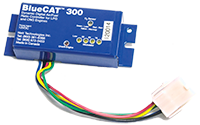BlueCAT™ 300
Digital Air-to-Fuel Ratio Controller
 The BlueCAT™ 300 air-fuel ratio controller is a closed-loop system and includes a zirconium oxygen (O2) sensor, fuel system control solenoid and an ECU. The ECU receives a feedback signal from the O2 sensor and modulates the solenoid to maintain the engine A/F ratio at the stoichiometric point, thereby maximizing catalyst performance.
The BlueCAT™ 300 air-fuel ratio controller is a closed-loop system and includes a zirconium oxygen (O2) sensor, fuel system control solenoid and an ECU. The ECU receives a feedback signal from the O2 sensor and modulates the solenoid to maintain the engine A/F ratio at the stoichiometric point, thereby maximizing catalyst performance.
The fundamental reactions in a 3-way catalyst are between CO (Carbon Monoxide) and HC (Hydrocarbons) on one side and NOx (Oxides of Nitrogen) on the other. To achieve high conversions of all three emissions simultaneously, the air/fuel ratio must be at the stoichiometric ratio. Simply, this means the amount of CO and HC are in proportion with the amount of NOx present in the exhaust – these gases combine to form water, nitrogen and carbon dioxide.
The BlueCAT™ 300 ECU is packaged in a rugged metal enclosure suitable for dash or engine compartment installation. Included on the control unit are self-diagnostic LED indicators which allow for monitoring of its operation. This feature provides a powerful tool for engine operators and service technicians, which minimizes the chances of system malfunction and/or the release of excessive emissions.
The BlueCAT™ 300 system can control A/F mixtures on carbureted engines fueled by liquefied petroleum gas (LPG, “propane”, “propane-butane”) and by Compressed Natural Gas (CNG).
It is primarily designed to work with air-valve type gaseous carburetor systems, including IMPCO, Nolff’s, and equivalent products. The controller is also compatible with most venturi-type gaseous carburetors, such as Aisan, Beam, or Garretson. The controller is not intended, nor legal for installation on gasoline fueled engines, or for use on engines with electronic fuel injection systems. To install either BlueCAT system on a gasoline fueled engine it is first necessary to convert it to a carbureted LPG/CNG fuel system, after which installation can occur.
The main functional components of the BlueCAT™ 300 systems are the Electronic Control Unit (ECU), oxygen sensor, and solenoid valve. The oxygen (O2) sensor, installed in the vehicle exhaust system upstream of the Nett 3-way catalytic converter or catalytic muffler, continuously monitors the exhaust gas composition. Lean A/F mixtures produce exhaust gases of high oxygen concentration, while rich A/F mixtures produce exhaust gases with little or no oxygen. A feedback signal from the oxygen sensor is passed to the ECU, which controls the vehicle’s fuel system to maintain the optimal, stoichiometric A/F ratio. A/F mixture control is achieved by biasing the diaphragm in the fuel regulator using vacuum taken from an area above the throttle in the fuel mixer. This vacuum signal is passed to the fuel regulator through the solenoid valve. ECU-controlled modulation of this valve determines the amount of vacuum signal that can pass to the regulator. The more vacuum passed to the regulator, the more restricted the flow of fuel and, consequently, the leaner the A/F mixture.
Since the A/F mixture can only be made leaner (as opposed to richer) by the described control mechanism, it is required that the vehicle’s fuel system be calibrated to a rich mixture during the set up of the controller. Once installed and set up, as outlined in the set up procedures, the BlueCAT™ 300 controller leans the mixture, as may be required at different speed and load conditions, to maintain a stoichiometric A/F ratio.
Feedback air valves must be used with IMPCO carburetors for best control:
- Model 100 Carbs use IMPCO P/N: AV1-1447-2
- Model 200 Carbs use IMPCO P/N: AV1-1245-2
For the installation details and part numbers please check our Document Downloads section on the right side of this page. Or contact one of our customer service representatives today at our toll-free number 1-800-361-6388.


